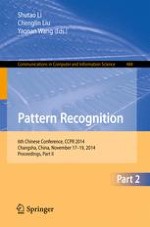2014 | OriginalPaper | Buchkapitel
Study the Moving Objects Extraction and Tracking Used the Moving Blobs Method in Fisheye Image
verfasst von : Wu Jianhui, Zhang Guoyun, Yuan Shuai, Guo Longyuan, Tan Mengxia
Erschienen in: Pattern Recognition
Verlag: Springer Berlin Heidelberg
Aktivieren Sie unsere intelligente Suche, um passende Fachinhalte oder Patente zu finden.
Wählen Sie Textabschnitte aus um mit Künstlicher Intelligenz passenden Patente zu finden. powered by
Markieren Sie Textabschnitte, um KI-gestützt weitere passende Inhalte zu finden. powered by
This paper discusses a method of moving object detection and tracking in fisheye video sequences which based on the moving blob method. The fisheye lens has a very large angle of view and it has a better effective used at the no blind surveillance system, but the big distortion of the fisheye image that makes it difficult to achieve the intelligent function. In this paper some algorithms had been discussed which about detect and track the moving objects in the fisheye video sequences. It was divided three steps to discuss the processing algorithm. Firstly, the method of how to calculate the moving blob was discussed in fisheye image. This method included four main algorithms which are the background extracted algorithm, background updated algorithm, the algorithm of fisheye video sequence subtracted with the background to get the moving blobs, the algorithm of remove the shadow of blobs in RGB space. Secondly, the algorithm of how to determine every extracts blob are the real moving object was designed through calculated the pixels with threshold, it can discard the fault moving object. Lastly, the algorithm of tracking the moving objects was designed which based on the moving blobs of selected through calculated the geometry center of blobs. The experiment indicated that every algorithm have a better processing effective to the moving object in fisheye video sequences. The moving object can be detected effectively and stable. When too many objects are at the edge of the image, it is difficult to track every object because of the adhesions which are influenced by the large distortion. This method can be used in the large area fisheye surveillance system when there are not too many objects moving simultaneously.
